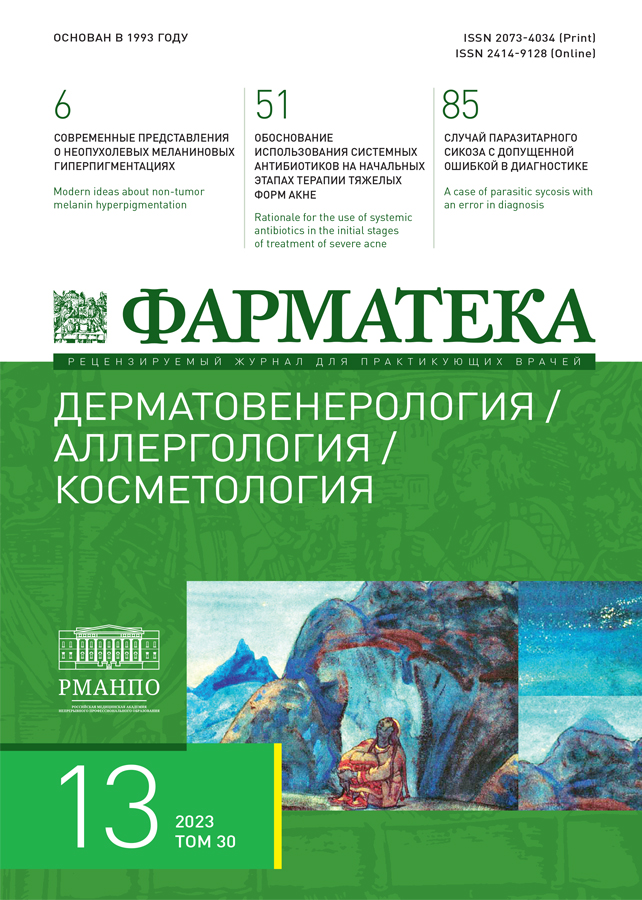Modern ideas about non-tumor melanin hyperpigmentation
- 作者: Kruglova L.S.1, Bezborodova A.V.1, Gryazeva N.V.1, Semizidis A.T.1, Bakulev A.L.1, Ravodin R.A.1
-
隶属关系:
- Central State Medical Academy of the Administrative Department of the President of the Russian Federation
- 期: 卷 30, 编号 13 (2023)
- 页面: 6-13
- 栏目: Reviews
- URL: https://journals.eco-vector.com/2073-4034/article/view/625911
- DOI: https://doi.org/10.18565/pharmateca.2023.13.6-13
- ID: 625911
如何引用文章
详细
Melanin hyperpigmentation (HP) is a fairly common reason for visiting dermatologists and cosmetologists. In clinical practice, melasma and secondary post-inflammatory HPs are the most common. Tyrosinase is considered to be the key enzyme in the melonogenesis disorder. At the same time, inhibition of the tyrosinase enzyme activity is the safest and most effective way to reduce HP today. However, the clinical effectiveness of current tyrosinase inhibitors is limited due to the fact that they have generally been selected based on their ability to inhibit fungal tyrosinase. In recent studies, thiamidol has been characterized as a particularly potent inhibitor of human tyrosinase. In vitro, thiamidol was superior to commonly used HP inhibitors such as arbutin, kojic acid, and hydroquinone. This superiority of thiamidol compared to hydroquinone was confirmed in studies in vivo.
全文:
作者简介
L. Kruglova
Central State Medical Academy of the Administrative Department of the President of the Russian Federation
编辑信件的主要联系方式.
Email: kruglovals@mail.ru
ORCID iD: 0000-0002-5044-5265
Dr. Sci. (Med.), Professor, Head of the Department of Dermatovenereology and Cosmetology
俄罗斯联邦, MoscowA. Bezborodova
Central State Medical Academy of the Administrative Department of the President of the Russian Federation
Email: pharmateca@yandex.ru
ORCID iD: 0009-0007-6213-9496
俄罗斯联邦, Moscow
N. Gryazeva
Central State Medical Academy of the Administrative Department of the President of the Russian Federation
Email: pharmateca@yandex.ru
ORCID iD: 0000-0003-3437-5233
俄罗斯联邦, Moscow
A. Semizidis
Central State Medical Academy of the Administrative Department of the President of the Russian Federation
Email: pharmateca@yandex.ru
ORCID iD: 0009-0007-5413-0125
俄罗斯联邦, Moscow
A. Bakulev
Central State Medical Academy of the Administrative Department of the President of the Russian Federation
Email: pharmateca@yandex.ru
ORCID iD: 0000-0002-1450-4942
俄罗斯联邦, Moscow
R. Ravodin
Central State Medical Academy of the Administrative Department of the President of the Russian Federation
Email: pharmateca@yandex.ru
ORCID iD: 0000-0002-0737-0317
俄罗斯联邦, Moscow
参考
- Потекаев Н.Н., Круглова Л.С. Гиперпигментация: причины возникновения и методы коррекции. Клиническая дерматология и венерология. 2012;10(6):65–70. [Potekaev N.N., Kruglova L.S. Hyperpigmentation: causes and methods of correction. Klinicheskaya dermatologiya i venerologiya. 2012;10(6):65–70. (In Russ.)].
- Круглова Л.С., Иконникова Е.В. Гиперпигментация кожи: современные взгляды на этиологию и патогенез (часть 1). Российский журнал кожных и венерических болезней. 2017;20(3):178–83. [Kruglova L.S., Ikonniko-va E.V. kin hyperpigmentation: modern views on etiology and pathogenesis (part 1).Rossiiskii zhurnal kozhnykh i venericheskikh boleznei. 2017;20(3):178–83. (In Russ.)].
- Li C., et al. Melanogenesis and the Targeted Therapy of Melanoma. Biomolecul. 2022;12(12):1874. doi.org/10.3390/biom12121874.
- Slominski R.M., et al. Melanoma, melanin, and melanogenesis: The Yin and Yang relationship. Front. Oncol. 2022;12:842496. doi: 10.3389/fonc.2022.842496.
- Solano F. Photoprotection and skin pigmentation: Melanin-related molecules and some other new agents obtained from natural sources. Molecules. 2020;25(7):1537. doi: 10.3390/molecules25071537.
- Piеtowska Z., Nowicka D., Szepietowski J.C. Understanding melasma-how can pharmacology and cosmetology procedures and prevention help to achieve optimal treatment results? a narrative review. International J Environment Res Public Health. 2022;19(19):12084. doi: 10.3390/ijerph191912084.
- Regazzetti C., et al. Melanocytes sense blue light and regulate pigmentation through opsin-3. J Investigat Dermatol. 2018;138(1):171–78. doi: 10.1016/j.jid.2017.07.833.
- Mione M., Bosserhoff A. MicroRNAs in melanocyte and melanoma biology. Pigment Cell Melanoma Res. 2015;28:340–54.
- Dai X., Rao C., Li H., et al. Regulation of pigmentation by microRNAs: MITF-dependent microRNA-211 targets TGF-β receptor 2. Pigment Cell Melanoma Res. 2015;28(2):217–22.
- Roberts W.E. Pollution as a risk factor for the development of melasma and other skin disorders of facial hyperpigmentation is there a case to be made? J Drugs Dermatol. 2015; 14(4):337–41.
- Kaufman B.P., Aman T., Alexis A.F. Postinflammatory hyperpigmentation: epidemiology, clinical presentation, pathogenesis and treatment. Am J Clin Dermatol. 2018;19(4):489–503. doi: 10.1007/s40257-017-0333-6.
- Callender V.D., et al. Effects of topical retinoids on acne and post-inflammatory hyperpigmentation in patients with skin of color: a clinical review and implications for practice. Am J Clin Dermatol. 2022;23(1):69–8. Doi: /10.1007/s40257-021-00643-2.
- Taylor S.C., et al. Acne vulgaris in skin of color. J. Am. Acad. Dermatol. 2002;46(2):S98–106. doi: 10.1067/mjd.2002.120791.
- Perry P.K., et al. Defining pseudofolliculitis barbae in 2001: a review of the literature and current trends. J Am Acad Dermatol. 2002;46(2):S113–19. doi.org/10.1067/mjd.2002.120789.
- Liu W., Chen Q., Xia Y. New mechanistic insights of melisma. Clin Cosmetic Investigat Dermatol. 2023;16:429–42. doi: 10.2147/CCID.S396272.
- Nautiyal A., Wairkar S. Management of hyperpigmentation: Current treatments and emerging therapies. Pigment Cell Melanoma Res. 2021;34(6):1000–14. doi: 10.1111/pcmr.12986.
- Passeron T., et al. Laser treatment of hyperpigmented lesions: position statement of the European Society of Laser in Dermatology. J Eur Acad Dermatol Venereol. 2019;33(6):987–1005. doi: 10.1111/jdv.15497.
- Leung A.K.C., Lam J.M., Barankin B., et al. Acanthosis Nigricans: An Updated Review. Curr Pediatr Rev. 2022;19(1):68–82.
- Hermitte-Gandoliere A., Petitpain N., Lepelley M., et al. Pigmentation cutanee liee a l’extravasation de fer injectable. Analyse de la base francaise de pharmacovigilance de 2000 a 2016.
- Draelos Z.D. A split-face evaluation of a novel pigment-lightening agent compared with no treatment and hydroquinone. J Am Acad Dermatol. 2015;72:105–7.
- Makhecha M., Nagzarkar R., Khatib Y., Khade A. A comparative study of the efficacy of 2% hydroquinone, 2% kojic acid and 30% glycolic peel in the treatment of facial melasma and evaluation of melanin content using SIAscopy – a novel objective method of assessment. Sch J App. Med Sci. 2016;4:3948–53.
- Ogbechie-Godec O.A., Elbuluk N. Melasma: an up-to-date comprehensive review. Dermatol Ther. (Heidelberg). 2017;7:305–18.
- Lee S.Y., Baek N., Nam T.G. Natural, semisynthetic and synthetic tyrosinase inhibitors. J Enzyme Inhib Med Chem. 2016;31:1–13.
- Arrowitz C., Schoelermann A.M., Mann T., et al. Effective Tyrosinase Inhibition by Thiamidol Results in Significant Improvement of Mild to Moderate Melasma. J Invest Dermatol. 2019;139(8): 1691–8.e6.
补充文件























